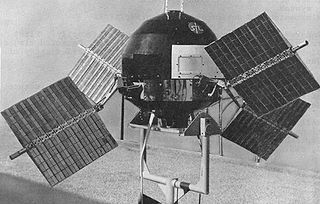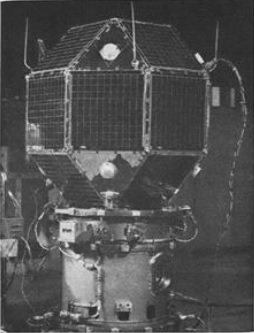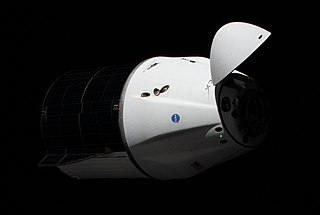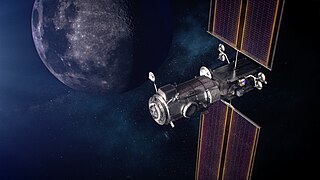High Energy Transient Explorer 1 (HETE-1) was a NASA astronomical satellite with international participation.

STS-41-D was the 12th flight of NASA's Space Shuttle program, and the first mission of Space Shuttle Discovery. It was launched from Kennedy Space Center, Florida, on August 30, 1984, and landed at Edwards Air Force Base, California, on September 5, 1984. Three commercial communications satellites were deployed into orbit during the six-day mission, and a number of scientific experiments were conducted, including a prototype extendable solar array that would eventually form the basis of the main solar arrays on the International Space Station (ISS).

STS-41 was the 36th Space Shuttle mission and the eleventh mission of the Space Shuttle Discovery. The four-day mission had a primary objective of launching the Ulysses probe as part of the "International Solar Polar Mission" (ISPM).

Project Echo was the first passive communications satellite experiment. Each of the two American spacecraft, launched in 1960 and 1964, were metalized balloon satellites acting as passive reflectors of microwave signals. Communication signals were transmitted from one location on Earth and bounced off the surface of the satellite to another Earth location.

Explorer 6, or S-2, was a NASA satellite, launched on 7 August 1959, at 14:24:20 GMT. It was a small, spheroidal satellite designed to study trapped radiation of various energies, galactic cosmic rays, geomagnetism, radio propagation in the upper atmosphere, and the flux of micrometeorites. It also tested a scanning device designed for photographing the Earth's cloud cover. On 14 August 1959, Explorer 6 took the first photos of Earth from a satellite.

Time History of Events and Macroscale Interactions during Substorms (THEMIS) mission began in February 2007 as a constellation of five NASA satellites to study energy releases from Earth's magnetosphere known as substorms, magnetic phenomena that intensify auroras near Earth's poles. The name of the mission is an acronym alluding to the Titan Themis.
The Space Test Program (STP) is the primary provider of spaceflight for the United States Department of Defense (DoD) space science and technology community. STP is managed by a group within the Advanced Systems and Development Directorate, a directorate of the Space and Missile Systems Center of the United States Space Force. STP provides spaceflight via the International Space Station (ISS), piggybacks, secondary payloads and dedicated launch services.

The Active Cavity Radiometer Irradiance Monitor Satellite, or ACRIMSAT was a satellite carrying the ACRIM-3 instrument. It was one of the 21 observational components of NASA's Earth Observing System program. The instrument followed upon the ACRIM-1 and ACRIM-2 instruments that were launched on multi-instrument satellite platforms. ACRIMSAT was launched on 20 December 1999 from Vandenberg Air Force Base as the secondary payload on the Taurus launch vehicle that launched KOMPSAT. It was placed into a high inclination of 98.30°, at 720 km. Sun-synchronous orbit from which the ACRIM-3 instrument monitored total solar irradiance (TSI). Contact with the satellite was lost on 14 December 2013.

Kosmos 14, also known as Omega No.1, was a satellite which was launched by the Soviet Union in 1963. It was an Omega satellite, derived from the Dnepropetrovsk Sputnik series.

The Suomi National Polar-orbiting Partnership, previously known as the National Polar-orbiting Operational Environmental Satellite System Preparatory Project (NPP) and NPP-Bridge, is a weather satellite operated by the United States National Oceanic and Atmospheric Administration (NOAA). It was launched in 2011 and is currently in operation.
Technology Education Satellite (TechEdSat) is a successful nano-sat flight series conducted from the NASA Ames Research Center in collaboration with numerous universities. While one of the principal aims has been to introduce young professionals and university students to the practical realm of developing space flight hardware, considerable innovations have been introduced. In addition, this evolving flight platform has tested concepts for Low Earth Orbit (LEO) sample return, as well as planetary nano-sat class mission concepts.
USA-126, also known as GPS IIA-17, GPS II-26 and GPS SVN-40, is an American navigation satellite which forms part of the Global Positioning System. It was the seventeenth of nineteen Block IIA GPS satellites to be launched.

Explorer 22 was a small NASA ionospheric research satellite launched 9 October 1964, part of NASA's Explorer Program. It was instrumented with an electrostatic probe, four radio beacons for ionospheric research, a passive laser tracking reflector, and two radio beacons for Doppler navigation experiments. Its objective was to provide enhanced geodetic measurements of the Earth as well as data on the total electron content in the Earth's atmosphere and in the satellite's immediate vicinity.
NASA's Pathfinder Technology Demonstrator (PTD) Project will test the operation of a variety of novel technologies on a type of nanosatellites known as CubeSats, providing significant enhancements to the performance of these versatile spacecraft. Each of the five planned PTD missions consist of a 6-unit (6U) CubeSat with expandable solar arrays.

Lincoln Experimental Satellite 1, also known as LES-1, was a communications satellite, the first of nine in the Lincoln Experimental Satellite program. Launched by the United States Air Force (USAF) on February 11, 1965, it pioneered many then-advanced technologies including active use of the military's SHF band to service hundreds of users. LES-1 did not have a successful operational life due to being placed in a suboptimal orbit, and it ceased transmissions in 1967. After 45 years of inactivity, LES-1 spontaneously resumed transmissions in 2012 making it one of the oldest zombie satellites.

SpaceX CRS-22, also known as SpX-22, was a Commercial Resupply Services (CRS) mission to the International Space Station (ISS) that launched at 17:29:15 UTC on 3 June 2021. The mission is contracted by NASA and is flown by SpaceX using a Cargo Dragon 2. This is the second flight for SpaceX under NASA's CRS Phase 2 contract awarded in January 2016.

Lincoln Experimental Satellite 2, also known as LES-2, was a communications satellite, the second of nine in the Lincoln Experimental Satellite. Launched by the United States Air Force (USAF) on 6 May 1965, it demonstrated many then-advanced technologies including active use of the military's SHF band to service hundreds of users.

Lincoln Experimental Satellite 4, also known as LES-4, was a communications satellite, the fourth of nine in the Lincoln Experimental Satellite, and the first of the series designed for operations at geosynchronous altitudes. Launched by the United States Air Force (USAF) on 21 December 1965, it demonstrated many then-advanced technologies including active use of the military's SHF band to service hundreds of users.

SpaceX CRS-26, also known as SpX-26, was a Commercial Resupply Service mission to the International Space Station (ISS) launched on 26 November 2022. The mission was contracted by NASA and flown by SpaceX using a Cargo Dragon. This was the sixth flight for SpaceX under NASA's CRS Phase 2 contract awarded in January 2016.

The Habitation and Logistics Outpost (HALO), also called the Minimal Habitation Module (MHM) and formerly known as the Utilization Module, is a scaled-down habitation module as part of the Lunar Gateway. It will be built by Northrop Grumman Innovation Systems. A single Falcon Heavy will launch HALO along with the PPE module and Halo Lunar Communication System, no earlier than November 2025.















